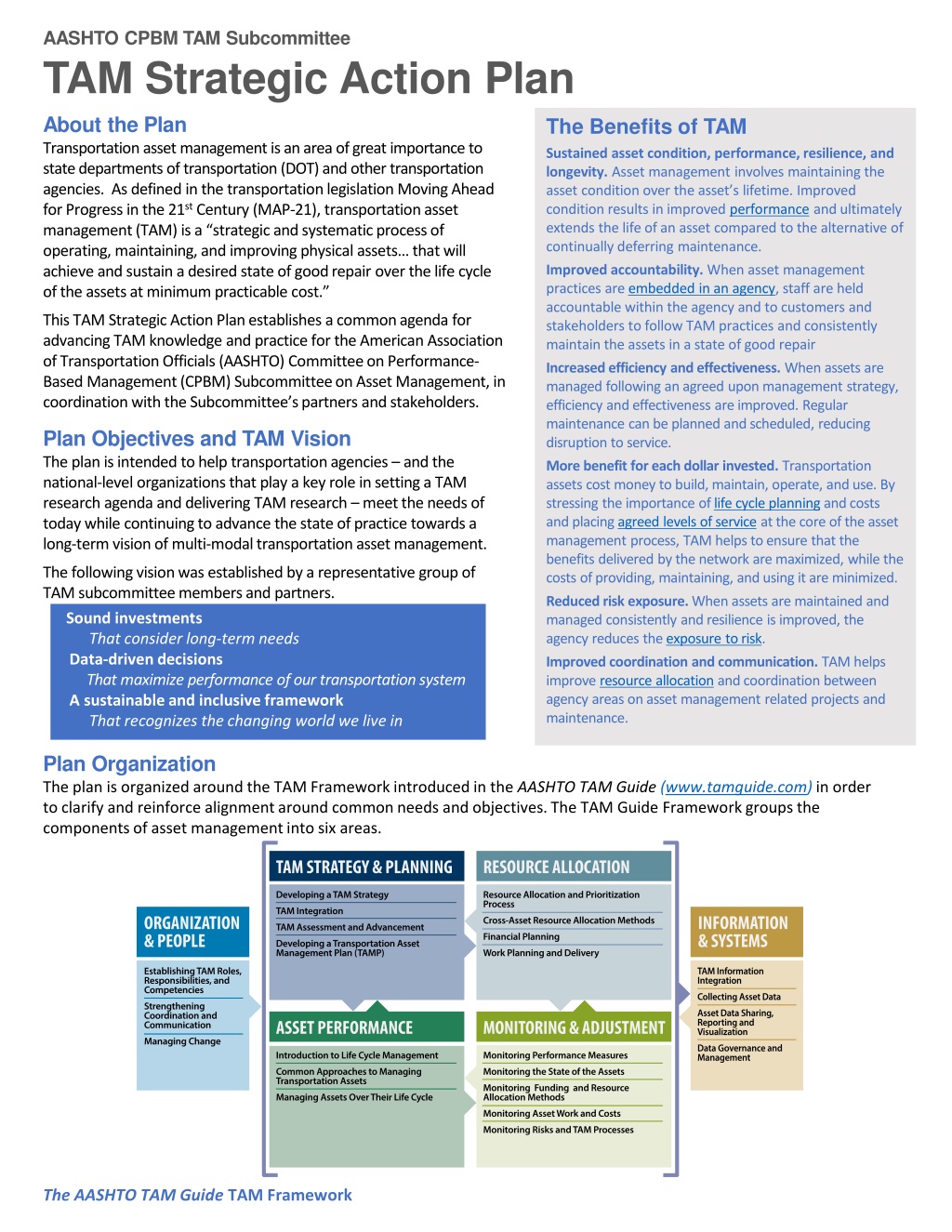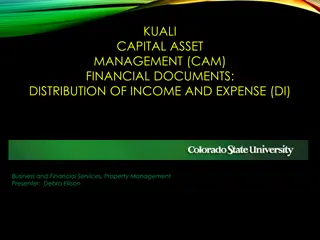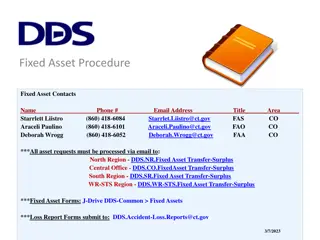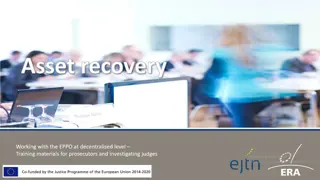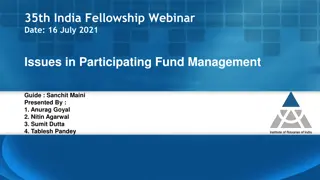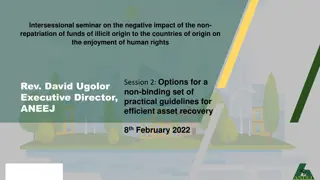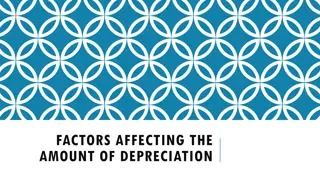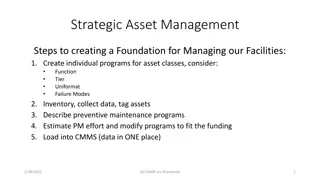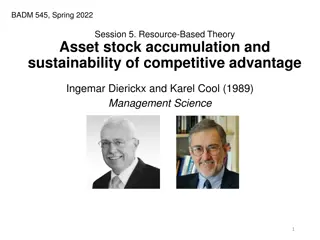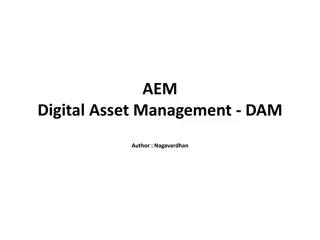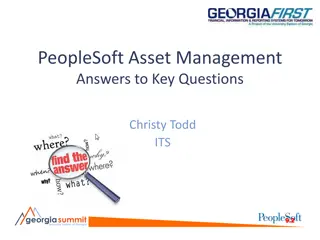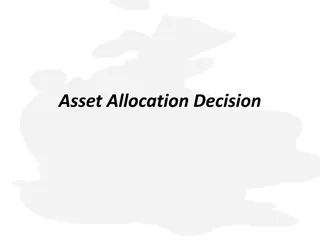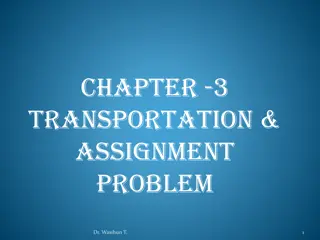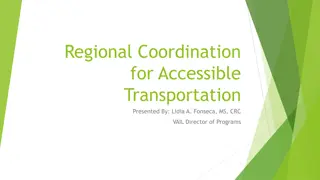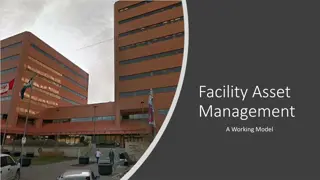Transportation Asset Management Strategic Action Plan
Transportation Asset Management (TAM) is crucial for state transportation departments to operate, maintain, and improve physical assets efficiently. The TAM Strategic Action Plan aims to enhance TAM practices by emphasizing sustained asset condition, accountability, efficiency, and effectiveness. The plan focuses on objectives such as increased efficiency, improved coordination, reduced risk exposure, and long-term vision for TAM. It highlights the importance of data-driven decisions, sound investments, and a sustainable framework for transportation asset management.
Download Presentation

Please find below an Image/Link to download the presentation.
The content on the website is provided AS IS for your information and personal use only. It may not be sold, licensed, or shared on other websites without obtaining consent from the author. Download presentation by click this link. If you encounter any issues during the download, it is possible that the publisher has removed the file from their server.
E N D
Presentation Transcript
AASHTO CPBM TAM Subcommittee TAM Strategic Action Plan About the Plan Transportation asset management is an area of great importance to state departments of transportation (DOT) and other transportation agencies. As defined in the transportation legislation Moving Ahead for Progress in the 21st Century (MAP-21), transportation asset management (TAM) is a strategic and systematic process of operating, maintaining, and improving physical assets that will achieve and sustain a desired state of good repair over the life cycle of the assets at minimum practicable cost. The Benefits of TAM Sustained asset condition, performance, resilience, and longevity. Asset management involves maintaining the asset condition over the asset s lifetime. Improved condition results in improved performance and ultimately extends the life of an asset compared to the alternative of continually deferring maintenance. Improved accountability. When asset management practices are embedded in an agency, staff are held accountable within the agency and to customers and stakeholders to follow TAM practices and consistently maintain the assets in a state of good repair This TAM Strategic Action Plan establishes a common agenda for advancing TAM knowledge and practice for the American Association of Transportation Officials (AASHTO) Committee on Performance- Based Management (CPBM) Subcommittee on Asset Management, in coordination with the Subcommittee s partners and stakeholders. Increased efficiency and effectiveness. When assets are managed following an agreed upon management strategy, efficiency and effectiveness are improved. Regular maintenance can be planned and scheduled, reducing disruption to service. Plan Objectives and TAM Vision The plan is intended to help transportation agencies and the national-level organizations that play a key role in setting a TAM research agenda and delivering TAM research meet the needs of today while continuing to advance the state of practice towards a long-term vision of multi-modal transportation asset management. More benefit for each dollar invested. Transportation assets cost money to build, maintain, operate, and use. By stressing the importance of life cycle planning and costs and placing agreed levels of service at the core of the asset management process, TAM helps to ensure that the benefits delivered by the network are maximized, while the costs of providing, maintaining, and using it are minimized. The following vision was established by a representative group of TAM subcommittee members and partners. Sound investments That consider long-term needs Data-driven decisions That maximize performance of our transportation system A sustainable and inclusive framework That recognizes the changing world we live in Plan Organization The plan is organized around the TAM Framework introduced in the AASHTO TAM Guide (www.tamguide.com) in order to clarify and reinforce alignment around common needs and objectives. The TAM Guide Framework groups the components of asset management into six areas. Reduced risk exposure.When assets are maintained and managed consistently and resilience is improved, the agency reduces the exposure to risk. Improved coordination and communication. TAM helps improve resource allocation and coordination between agency areas on asset management related projects and maintenance. The AASHTO TAM Guide TAM Framework
Long Term (5-10 Years) >> XC XC for advancing TAM knowledge and practice for the AASHTO Committee on Performance-Based The Transportation Asset Management (TAM) Strategic Action Plan defines a common agenda Integrate Asset Management into college- MA OP AP XC RA SP level courses to motivate/ expose young Develop and maintain web-based index of IS Database of TAM Experts Management Student Information and Systems Organization and People Management (CPBM) Subcommittee on Asset Management, in coordination with the TAM Framework Key Cross-Cutting Topics Develop National Resource Allocation Asset Performance Develop Asset and Adjustment professionals to TAM. TAM Strategy and Planning Monitoring Exercises TAM experts. OP involvement, and inspire leaders to encourage OP Develop and deliver a workshop to provide participation by employees of the majority of Subcommittee s partners and stakeholders. Develop TAM Committee Internal TAM Workforce Development Workshop agencies with tools to enhance staff Onboarding Procedure Educate agency employees regarding understanding and buy-in for TAM. existence, mission, opportunities for US states and other agencies. AP MA XC (APWA) and Institute of Public Works Engineering Establish methods, measures, and standard SP TAM Strategic Action Plan face in condensing TAM into enjoyable and IS including American Public Works Association Australasia (IPWEA). Strengthen connections Identify strategies for making adjustments Address challenges that TAM practitioners criteria to assess impact of TAM research. Provide guidance and examples on how to Align TAM with ISO/international practice management, and project prioritization. classes. Ensure direct linkages between Assess Research Impact based on performance between asset to the World Road Association (PIARC). develop TAM plans for all asset classes. TAM Data Visualization Adjust Between TAMPs Recommended Practice understandable pieces for different Standards and Bodies Develop AASHTO TAM Identify Strategies to Develop Methods to condition assessment, performance Provide Training on Connect with IAM CPBM TAM Subcommittee audiences. AP XC SP synergies. Establish mechanism to coordinate committee business processes with the TAM (APTA), and the Association of Metropolitan Provide a framework where states can learn American Public Transportation Association roadmap to ensure focused results, sharing TAM Plans and Practices Transportation Research Board (TRB), the << Near Term (1-3 Years) ideas and research status to capitalize on monthly knowledge transfer on research Process into Committee Reporting Requirements progress and accomplishments. Conduct Implementation Activities Align disparate data needs for Federal incorporating elements of the structure, Align Data with Federal from peers and noteworthy references, Integrate the Research description, and approach as desired. Align research needs statements and coordination meetings with related committees, including those of the Identify Noteworthy Committee Activities Planning Organizations (AMPO). planning and reporting. Structures
Research Activities TAM Strategic Action Plan (continued) decisions in traditional planning processes. and MPOs are linking and including TAM Identify noteworthy practices in how DOTs Processes Planning and Performance Integrate Required data governance. Research BIM applications to support DOTs' Governance through BIM Support Data promote and mature TAM practices. value and benefits of TAM to continue to Research approaches to show quantifiable Realized from TAM Assess Benefits as to their practices during COVID. Survey and interview State DOTs and others Uncertainty Practices for Managing Assess Successful related to TAM and TPM. tools, curriculum, and certification programs Develop and lay the foundation for multiple Workforce Development Education, Training and Support TAM and TPM all-hazards risk and resilience analysis. collection of tools and techniques for agencies projects born out of NCHRP 23-09 to yield a Establish a series of individual research to Develop National Standards Resilience Research Program Establish a Risk and << Near Term (1-3 Years) SP OP SP MA IS SP Assets. of System Level Valuation of Transportation forthcoming Guide to Computation and Use Support implementation activities for the Valuation on System Level Asset Implement Guidance that information needs to be generated. agency as well as guidance on how frequently technologies for asset analysis can offer an Research to understand what the latest Collection Technology Advance Asset Data measures to state-level TAM decision making. determine applicability and usability of these performance measure requirements to Evaluate and assess existing national-level for Pavements Measures and Metrics Evaluate Federal performance measures. and resilience being on par with traditional project and network levels. Support risk incorporate quantitative risk assessment at Develop methods to allow agencies to Project and Network Levels Incorporate Risk at calculations and decision-making. environmental indicators in TAM Research the use of equity, economic, and Indicators in TAM Assess Socio-Economic AP RA MA SP IS management strategies in TAM practice. agencies to use in incorporating change and synthesis of noteworthy practices for Develop a framework, recommended actions, Management in TAM Incorporate Change TAM program or practice. a transportation agency implemented a studies that document, in great detail, how Identify and develop multi-media case Case Studies Develop Detailed TAM performance and other performance areas. improvements that impact asset class that promote sustainable capital asset Research effective corridor planning strategies Capital Projects Performance by Bundling Improve Asset management and resource allocation. area) plans that can be used for efficient asset Organize a framework for corridor (or system/ Approaches Planning and Allocation Develop Corridor levels for targeted professionals. exchanges at the regional and national Continue to deliver thematic TAM peer National Peer Exchanges Conduct Regional and RA XC RA OP XC agencies. strategies for various asset categories and engage stakeholders in developing TAM Develop communication tools designed to in TAM Engage Stakeholders condition assessment for all types of assets. Document and provide examples of Protocols Condition Assessment Create Catalog of applications of big data analytics to TAM. Create case studies addressing noteworthy Data Case Studies Develop TAM Big program/implementation. internal staff to become involved in TAM the capabilities of a TAM team/staff or attract development and training in order to enhance Synthesize best practices for workforce Best Practices Staff Development Synthesize Internal community on data governance. Create knowledge throughout the TAM Governance Guidebook Develop Data Long Term (5-10 Years) >> OP OP AP IS IS
CPBM TAM Subcommittee TAM Strategic Action Plan Plan Development A 2019 TAM Strategic Planning Workshop, held on October 17-18, 2019 in Irvine, California, provided the foundation for the plan. With over 45 attendees representing more than 35 organizations, the discussions brought together many voices and perspectives to identify, define, and prioritize the specific opportunities for TAM advancements that will deliver real value to transportation agencies. Areas of Need TAM has been a focus area for DOTs in the U.S. for over 15 years, paralleling similar efforts to improve asset management in transportation and other infrastructure-intensive industries in the U.S. and abroad. Over this period, transportation agencies have worked to increase their understanding of the value and performance of existing assets; and implement improved asset management systems and approaches. At the outset of the 2019 TAM Strategic Planning Workshop, participants defined the goals and desired outcomes to be addressed by the TAM Strategic Action Plan that would shape the continued advancement of TAM practice over a ten-year timeframe. Timeframe 2 Years Desired Products and Outcomes Product: High level CEO instruction in what asset management can do for an organization and its long term investment decisions Outcome: Embedded TAM business process that are sustainable across major leadership changes Product: Means and methods for before-and-after assessments Product: Performance measures for additional assets Outcome: Achieve greater consistency within asset classes Outcome: Fully integrated agency asset management, performance management, and risk management Product: Multimodal framework for TAM that enables consistency in language and approach across modes and assets Outcome: TAM processes, people, and information are working systematically o Transportation programs, project scopes, and budgets are set based on outputs of TAM analyses o TAM is integrated into all lines of business, and job descriptions include TAM Outcome: Increase the credibility of TAM programs by shifting from reporting-only to decisions based on investment scenarios o Optimum lifecycle strategies can be utilized on all assets o Increased use of multi-objective modeling techniques o Use greater percentage of model recommendations Outcome: Adopt meaningful performance measures that incorporate user experience Outcome: Implement TAM culture throughout all levels of the agency Outcome: Advance TAM practices towards international standards Outcome: Provide asset owners with TAM tools for addressing critical challenges Outcome: Increase availability of human and information resources for TAM: findable, searchable, usable 3-5 Years Much progress has been made in data driven decision-making, improved performance management, strengthened knowledge amongst practitioners, and the availability of resources to support TAM. The TAM Strategic Action Plan reflects these accomplishments while also highlighting the areas where future progress must break substantial new ground. 5-10 Years In certain areas, where the maturity of TAM practice is relatively high, there is the greatest need for implementation support. Further advancement in these areas is generally captured by the committee activities and implementation activities included in the plan. Examples include: Asset inventory and condition development TAM plan development Setting and reporting agency performance measures In other areas, where maturity is generally lower, there is a greater need for general or targeted research. These needs have been translated into the research activities included in the plan. Examples include: Applying a structured risk management approach Implementing corridor-based investment strategies Leveraging the capabilities of big data analytics and artificial intelligence Workshop survey and polling data helped establish baseline and desired future maturity levels for a variety of key TAM capabilities and competencies required to achieve these objectives. These data were used to help identify areas with needs best addressed by three improvement action types: implementation support, general or targeted research efforts, and the coordinated activities of the national-level organizations that play a key role in setting a TAM research agenda and delivering TAM research. The workshop culminated with the development of over 25 specific, actionable research and action statements. The action items presented in the TAM Strategic Action Plan are synthesized from these statements, organized according to the established AASHTO TAM Guide Framework, and categorized according to the three improvement action types.
